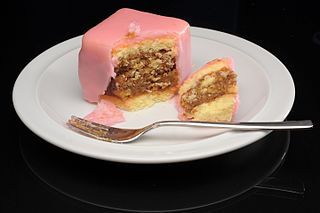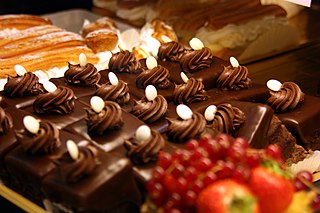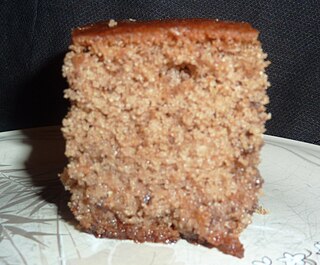Related Research Articles

A cookie, or a biscuit, is a baked or cooked snack or dessert that is typically small, flat and sweet. It usually contains flour, sugar, egg, and some type of oil, fat, or butter. It may include other ingredients such as raisins, oats, chocolate chips, nuts, etc.
Jamaican cuisine includes a mixture of cooking techniques, flavours and spices influenced by Amerindian, African, Irish, English, French, Portuguese, Spanish, Indian, Chinese and Middle Eastern people who have inhabited the island. It is also influenced by the crops introduced into the island from tropical Southeast Asia, many of which are now grown locally. A wide variety of seafood, tropical fruits and meats are available.

Fruitcake is a cake made with candied or dried fruit, nuts, and spices, and optionally soaked in spirits. In the United Kingdom, certain rich versions may be iced and decorated.

Nicaraguan cuisine includes a mixture of indigenous Native American cuisine, Spanish cuisine, and Creole cuisine. Despite the blending and incorporation of pre-Columbian and Spanish-influenced cuisine, traditional cuisine differs on the Pacific coast from the Caribbean coast. While the Pacific coast's main staple revolves around beef, poultry, local fruits, and corn, the Caribbean coast's cuisine makes use of seafood and coconut.

Christmas cake is a type of cake, often fruitcake, served at Christmas time in many countries.
Quinto may refer to:

A Banbury cake is a spiced, oval-shaped, currant-filled pastry. Since the mid-1800s Banbury cakes have grown more similar to Eccles cake but the earlier versions of Banbury cakes are quite different from the modern pastry. Besides currants, the filling typically includes mixed peel, brown sugar, rum, and nutmeg. Banbury cakes are traditionally enjoyed with afternoon tea.

Pionono describes different sweet or savory pastries from Granada, Spain, the Caribbean, South America, and the Philippines. It is named after Pope Pius IX's name in Spanish, Pío Nono.

Punschkrapfen or Punschkrapferl is a nougat and jam filled sponge cake soaked with rum from Austrian cuisine. Besides the filling, it is similar to the French petit four.

A rum cake or black cake is a type of dessert cake which contains rum. In most of the Caribbean, rum cakes are a traditional holiday season dessert, descended from the holiday puddings. Traditionally, dried fruit is soaked in rum for months and then added to dough prepared with sugar which has been caramelized by boiling in water. The result, also known as "black cake", is similar to a fruitcake, with a lighter texture.
Torta alla Monferrina, an autumn speciality of the Monferrato hills in north-west Italy, is a cake made from pumpkin, or apples and sugar, with amaretti, chocolate, eggs, and rum, and baked in the oven.

A rum baba or baba au rhum is a small yeast cake saturated in syrup made with hard liquor, usually rum, and sometimes filled with whipped cream or pastry cream. It is most typically made in individual servings but sometimes can be made in larger forms similar to those used for Bundt cakes.

Amandine is a Romanian chocolate layered cake filled with chocolate with caramel and fondant cream. Almond cream is sometimes used. As most Romanian cakes, they can be cut and served in 1-serving miniature cakes or as a big cake.

Karydopita is a Greek dessert cake made primarily from walnuts and covered in a sweet syrup. Its name is a compound word which derives from "karýdia" and "pita".

Raisin cake is a type of cake that is prepared using raisins as a main ingredient. Additional ingredients are sometimes used, such as chocolate and rum. Raisin cake dates back to at least the time of the reign of David, circa 1010–970 BCE. Boiled raisin cake is prepared by boiling various ingredients and then baking the mix in an oven. It dates back to at least the time of the American Civil War (1861–1865).
Gâteau nantais is a cake originating in the city of Nantes in France. Gâteau nantais is a soft, round pound cake, made of flour, sugar, salted butter, eggs, and almond meal, then dampened with a punch of rum and lemon, sometimes with an apricot gelée centre. The round shaped cake top is topped with a white glaze thinned with rum, although lemon or orange blossom water can be substituted if the cake is to be served to children. It is recommended to make the cake a day before it is intended to be served. It keeps very well. An earlier version of the recipe, without eggs, reportedly kept for three to four weeks. In the modern recipe, the icing is white, whereas earlier versions were an amber colour.

Cumberland rum nicky is a sweet shortcrust pastry tart or pie, commonly filled with dates and stem ginger, flavoured with rum, and sweetened with brown sugar. Rum nickies are associated with the historic county of Cumberland in northwest England, and the ingredients used in their manufacture reflect the county's former significance as a major import and trading centre for products of the UK's Caribbean colonies. As with many traditional foodstuffs, the precise list of ingredients can vary between different cooks and recipes, with currants and cinnamon being common additions or substitutions.
References
- ↑ Krystina Castella (2012). A World of Cake. Storey Publishing. pp. 60 and 74. ISBN 9781603424462 . Retrieved 6 May 2019.